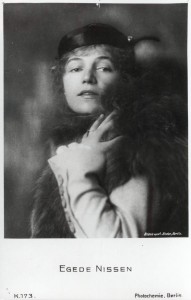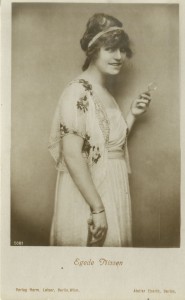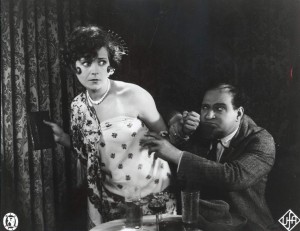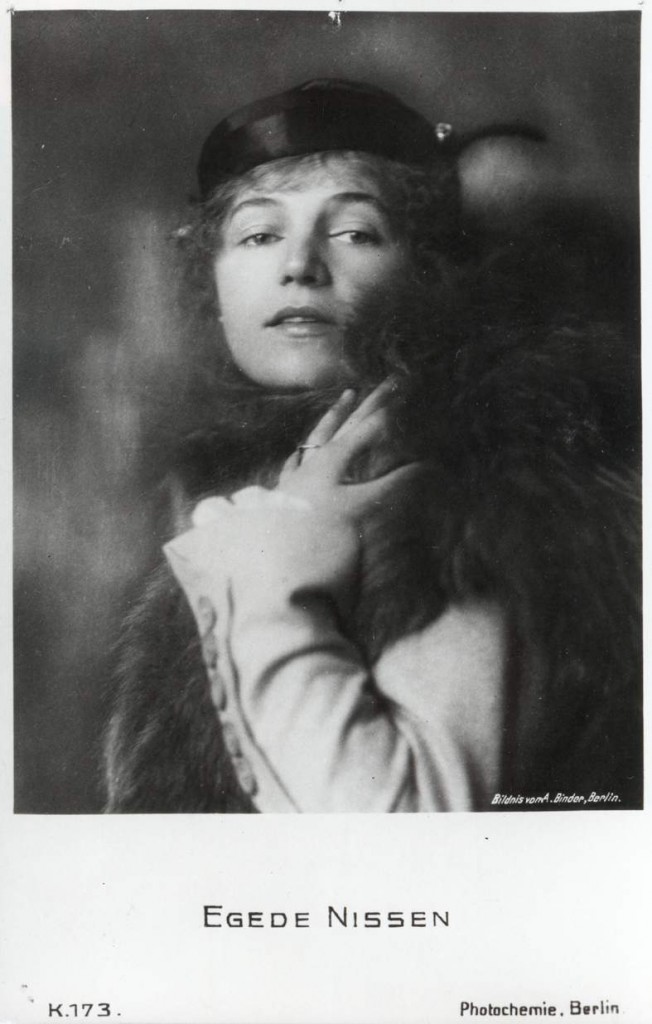by
Gunnar Iversen
During the 1910s and 1920s, Aud Egede-Nissen and her sisters Gerd and Ada made a name for themselves in the Nordic and German film industries as actors, producers, and directors. Like many female pioneers in the film industry, their work has been neglected. The contribution of the Egede-Nissen sisters, especially Aud, to silent film in the 1910s is remarkable given the odds they had to overcome as female producers in a male-dominated industry and the lack of tradition and experience in their home country, Norway.
The Egede-Nissen sisters were the daughters of a radical politician. Through her younger sisters, Aud became interested in the theatre and made her stage debut in Trondheim in 1911. Her sister Gerd had her first engagement as a film actor for Nordisk in Denmark in 1912. A year later, Aud joined her in Copenhagen, working for the Dania Biofilm company. Aud went on to Berlin in 1914, working at Kleines Theater auf der Bühne for a short period and appearing in her first German film as an actor in the Literaria production Teddy im Schlafsopha (Bjørn Bjørnson 1914). That same year she acted in at least three other German films, and by 1915 had made herself a name in the German film industry as an actor. In 1915 she appeared in at least sixteen German feature films and was about to become famous as a motion picture star.

Aud Egede-Nissen postcard. Private Collection.
In 1916, Aud met actor and director Georg Alexander. Alexander directed her in Wer wirft den ersten Stein auf Sie? in 1916, and in the same year they married. Together with her husband and sisters, Aud Egede-Nissen established a production company in Berlin. Egede-Nissen-Film Company GmbH produced ten features in 1917, the first of which was the comedy Ich heirate meine Puppe (Georg Alexander 1917) starring Aud in a comic role. Most of the thirty feature films the company produced were divided into three series, each with one of the three sisters as leading actor and star. The Egede-Nissen series, built around Aud, came in two waves, the first in 1917–18 and the second in 1918–19, with a total of eleven features. Some of these were dramatic tragedies, like Die Geburt der Venus (Georg Alexander 1917); others were detective films.
Aud Egede-Nissen was the producer for all thirty features, and in interviews she was represented as the ruling force behind the film company. When a Norwegian journalist visited her company in Berlin in 1918, he gave a vivid portrait of a large film production company, bursting with energy, making new films and copies of older films in their own laboratory, all ruled by one will, one person: “die schöne Egede Nissen” (“the beautiful Egede Nissen”) (Lie 1918).

Aud Egede-Nissen postcard. Private Collection
Unfortunately, it is difficult for film historians today to assess the film production output of the company. All but two of the films are lost, and the only existing Egede-Nissen-Film Company title with a users’ copy available for screening is Erblich belastet (Georg Alexander 1919), a film rediscovered in the Desmet collection of the Nederlands Filmmuseum in Amsterdam. Material from a second film, Der Todestraum (1918), exists in the Bundesarchiv in Germany. One assumes that as the ruling force behind the company, Aud Egede-Nissen did some writing and directing, but this question is difficult to answer at this point.
Erblich belastet recounts a narrative set in America. The story is full of clichés and abruptly changes tone in the middle when a slow melodrama becomes an action-filled Western. By the end, the film returns to the slow melodrama. The film is thus a curious mixture, presenting a mini-Western bracketed by a tragic melodrama about old sins, love, suicide, and triumphant love. This mix of genres and modes give the film an ”international” tone as it attempts to combine all the most attractive elements of European tragic melodrama with the speed, rhythm, and violence of the American Western.
In 1920, the company ceased production. Gerd Egede-Nissen left both stage and screen and returned to Norway. Ada married a Norwegian musician and returned to Norway to start a career on the stage under her new name, Ada Kramm. Only Aud remained in Berlin. She divorced Georg Alexander and married the actor Paul Richter. She later changed her name to Aud Richter, the name she kept for the rest of her life.
Today, Aud Egede-Nissen is internationally known for her acting in German films of the 1920s. She is remembered for her roles in two Ernst Lubitsch films, as Haidee in Sumurun (1920) and as Jane Seymour in Anna Boleyn (1920) as well as Cara Carozza in Fritz Lang’s Dr. Mabuse, der Spieler (1922). She also had major roles in F. W. Murnau’s Phantom (1922) and Die Austreibung (1923), and in Karl Grune’s Die Strasse (1923). From 1920 to 1929 she acted in at least thirty-nine German features, as well as a few Norwegian films. When sound film production started in Germany, she starred in Gerhard Lamprecht’s Zwischen Nacht und Morgen (1931).

Aud Egede-Nissen in unknown film. Private Collection.
In the late 1920s, Aud relocated to Norway and, like her younger sisters, returned to the stage. She worked mainly as an actor and director in the theatre for the rest of her life, but occasionally was mentioned as working on film projects. As late as 1962, a Norwegian film magazine noted that she had started work on a short drama-documentary about the Second World War.
Bibliography
Birett, Herbert, ed. Verzeichnis in Deutschland gelaufener Film—Entscheidungen der Filmzensur 1911–1920. Berlin: K.G. Saur, 1980.
Iversen, Gunnar. “Sisters of Cinema: Three Norwegian Actors and Their German Film Company, 1917–1920.” Nordic Explorations: Film Before 1930. Ed. John Fullerton and Jan Olsson. London: John Libbey, 1999. 93-101.
Lamprecht, Gerhard. Deutsche Stummfilme 1917–1918. Berlin: Deutsche Kinematek, 1969.
Lie, Jonas Jr. “Aud Egede Nissen - Norsk Kunstnerliv i Berlin II.” Ukens revy (1918). 234-235.
Usai, Paolo Cherchi and Codelli, Lorenzo, eds. Before Caligari: German Cinema, 1895–1920/Prima di Caligari: Cinema tedesco, 1895–1920. Pordenone: Le Giornate del Cinema Muto/Edizioni Biblioteca dell’Immagine, 1990.
Filmography
A. Archival Filmography: Extant Film Titles:
1. Aud Egede-Nissen as Producer
Der Todestraum. Prod.: Aud Egede-Nissen (Egede Nissen-Film Co. Germany 1918) si, b&w, 4 reels. Archive: Bundesarchiv-Filmarchiv.
Erblich belastet. Prod.: Aud Egede-Nissen, dir.: Georg Alexander, sc.: Elsae Cressin/Rudolf Báron (Egede Nissen-Film Co. Germany 1919) cas.: Ada von Ehlers, Georg Alexander, si, b&w, 4 reels. Archive: Bundesarchiv-Filmarchiv, EYE Filmmuseum.
2. Aud Egede-Nissen as Actress
Amarant, die Liebe einer Zigeunerin. Dir.: Martin Haras (Greenbaum-Film GmbH. Germany 1916) cas.: Aud Egede-Nissen, Nils Chrisander, si, b&w. Archive: Deutsche Kinemathek.
Homunculus p.IV: Die Rache des Homunculus. Dir.: Otto Rippert (Deutsche Bioscop Germany 1916) cas.: Olaf Fønss, Friedrich Kühne, Aud Egede-Nissen, si., b&w. Archive: Bundesarchiv-Filmarchiv, Bulgarska Nacionalna Filmoteka, Cinémathèque Royale de Belgique, Museum of Modern Art, Deutsche Kinemathek, Gosfilmofond, Deutsches Filminstitut, Cinémathèque Française, Danske Filminstitut.
Mary Wood, die Tochter des Sträflings. Dir.: Ernst Mölter (Adler-Film GmbH Germany 1919) cas.: Aud Egede-Nissen, Paul Rehkopf, si, b&w. Archive: EYE Filmmuseum.
Anna Boleyn. Dir.: Ernst Lubitsch (Messter-Film GmbH, Projektions-AG Union Germany 1920) cas.: Aud Egede-Nissen, Henny Porten, Emil Jannings, si, b&w. Archive: Bundesarchiv-Filmarchiv, Cinémathèque de Toulouse, Cinémathèque Royale de Belgique, Deutsches Filminstitut, Münchner Stadtmuseum [DEI], Museum of Modern Art, Deutsche Kinemathek, Gosfilmofond, Fondazione Cineteca Italiana, Cinemateca Romana, Choson Minjujui Inmingonghwaguk Kugga Yonghwa Munhongo, Svenska Filminstitutet .
Das Floss der Toten. Dir.: Carl Heinz Boese (Bayerische-Film GmbH. Germany 1920) cas.: Aud Egede-Nissen, Carl Clewing, si, b&w. Archive: Library of Congress.
Schiffe und Menschen. Dir.: Carl Heinz Boese (Bayerische-Film GmbH. Germany 1920) cas.: Aud Egede-Nissen, Otto Gebühr, si, b&w. Archive: Fondazione Cineteca Italiana.
Sumurun. Dir.: Ernst Lubitsch (Projektions-AG Union Germany 1920) cas.: Aud Egede-Nissen, Ernst Lubitsch, Pola Negri, Paul Wegener, si, b&w. Archive: Bundesarchiv-Filmarchiv, Cineteca del Friuli, Deutsches Filminstitut, Münchner Stadtmuseum, Filmoteka Narodowa, George Eastman Museum, Library of Congress, Gosfilmofond, Cinemateca Romana, Filmoteca Española, Cinémathèque Royale de Belgique, Choson Minjujui Inmingonghwaguk Kugga Yonghwa Munhongo, Danske Filminstitut, Academy Film Archive.
Das Geheimnis der Mumie. Dir.: Victor Janson (Projektions-AG Union Germany 1921) cas.: Aud Egede-Nissen, Magnus Stifter, Ferdinand von Alten, si, b&w. Archive: Bundesarchiv-Filmarchiv, EYE Filmmuseum.
Die Nacht der Einbrecher. Dir.: Uwe Jens Krafft (Münchener Lichtspielkunst AG. Germany 1921) cas.: Aud Egede-Nissen, Paul Richter, Karl Sick, si, b&w. Archive: Library of Congress.
Die Rote Mühle. Dir.: Carl Heinz Boese (Bayerische-Film GmbH. Germany 1921) cas.: Aud Egede-Nissen, Alfred Abel, Otto Gebühr, si, b&w. Archive: Gosfilmofond.
Dr. Mabuse, der Spieler. 1. Teil, Der Grosse Spieler. Dir.: Fritz Lang, sc.: Thea von Harbou (Uco-Film GmbH. Germany 1922) cas.: Aud Egede-Nissen, Rudolf Klein-Rogge, Rudolf Goetzke, si, b&w. Archive: Bulgarska Nacionalna Filmoteka, Bundesarchiv-Filmarchiv, Cinémathèque de Toulouse, Cinémathèque Québécoise, Cinémathèque Royale de Belgique, Svenska Filminstitutet , Deutsches Filminstitut, Münchner Stadtmuseum, Filmoteka Narodowa, George Eastman Museum, Library of Congress, Museum of Modern Art, BFI National Archive, Österreichisches Filmmuseum, Deutsche Kinemathek, Gosfilmofond, Cineteca Nazionale, Cinemateca Romana, UCLA Film & Television Archive, Choson Minjujui Inmingonghwaguk Kugga Yonghwa Munhongo, Filmarchiv Austria, Jugoslovenska Kinoteka, National Film and Sound Archive of Australia, Lobster Films.
Dr. Mabuse, der Spieler. 2. Teil, “Inferno”, Ein Spiel von Menschen unserer Zeit. Dir.: Fritz Lang, sc.: Thea von Harbou (Uco-Film GmbH. Germany 1922) cas.: Aud Egede-Nissen, Rudolf Klein-Rogge, Rudolf Goetzke, si, b&w. Archive: Bulgarska Nacionalna Filmoteka, Bundesarchiv-Filmarchiv, Cinémathèque de Toulouse, Cinémathèque Québécoise, Cinémathèque Royale de Belgique, Svenska Filminstitutet , Deutsches Filminstitut, Münchner Stadtmuseum, Filmoteka Narodowa, George Eastman Museum, Museum of Modern Art, Library of Congress, BFI National Archive, Österreichisches Filmmuseum, Deutsche Kinemathek, Gosfilmofond, Cineteca Nazionale, Cinemateca Romana, UCLA Film & Television Archive, Choson Minjujui Inmingonghwaguk Kugga Yonghwa Munhongo, Filmarchiv Austria, Jugoslovenska Kinoteka, National Film and Sound Archive of Australia, Lobster Films.
Phantom. Dir.: Friedrich Wilhelm Murnau, sc.: Thea von Harbou (Uco-Film GmbH. Germany 1922) cas.: Aud Egede-Nissen, Alfred Abel, Frieda Richard, si, b&w. Archive: Bundesarchiv-Filmarchiv, Cinémathèque Royale de Belgique, Deutsches Filminstitut, Münchner Stadtmuseum, Museum of Modern Art, EYE Filmmuseum, Gosfilmofond, Cineteca Nazionale, Filmoteca UNAM, Filmoteca Española, BFI National Archive, Danske Filminstitut, Jugoslovenska Kinoteka.
Die Strasse. Dir.: Karl Grune (Stern-Film GmbH. Germany 1923) cas.: Aud Egede-Nissen, Eugen Klöpf, Lucie Höflich, Max Schreck, si, b&w. Archive: Bundesarchiv-Filmarchiv, Cinémathèque Royale de Belgique, Cinemateca do Museu de Arte Moderna, Danske Filminstitut, Deutsches Filminstitut, Filmoteka Narodowa, Museum of Modern Art, Gosfilmofond, Cineteca Nazionale, Fondazione Cineteca Italiana, George Eastman Museum, Harvard Film Archive, Jugoslovenska Kinoteka, Deutsche Kinemathek.
Karusellen/Das Karussell des Lebens. Dir.: Dimitri Buchowetzki (Svensk Filmindustri Sweden & Germany 1923) cas.: Aud Egede-Nissen, Walter Janson, Alfons Fryland, si, b&w. Archive: Gosfilmofond.
Carlos und Elisabeth. Dir.: Richard Oswald (Richard Oswald-Film AG. Germany 1924) cas. Aud Egede-Nissen, Conrad Veidt, Wilhelm Dieterle, si, b&w. Archive: Bundesarchiv-Filmarchiv, Cinémathèque Royale de Belgique, Cinemateca do Museu de Arte Moderna, Cineteca Nazionale, BFI National Archive, EYE Filmmuseum, Filmoteca Española, Cinémathèque Française.
Die rote Maus. Dir.: Rudolf Meinert (Meinert-Film. Germany 1925) cas.: Aud Egede-Nissen, Paul Richter, Ressel Orla, si, b&w. Archive: BFI National Archive, Cinémathèque Royale de Belgique.
Pietro, der Korsar. Dir.: Arthur Robison (Ufa. Germany 1925) cas.: Aud Egede-Nissen, Paul Richter, Rudolf Klein-Rogge, si, b&w. Archive: Bundesarchiv-Filmarchiv, Gosfilmofond, Deutsche Kinemathek. .
Die Verrufenen. Dir.: Gerhard Lamprecht (National-Film AG. Germany 1925) cas.: Aud Egede-Nissen, Arthur Bergen, Bernhard Goetzke, Georg John, si, b&w. Archive: Bundesarchiv-Filmarchiv, Cinémathèque Québécoise, Cinémathèque Royale de Belgique, George Eastman Museum, Deutsche Kinemathek, Gosfilmofond, National Film and Sound Archive of Australia, UCLA Film & Television Archive, Academy Film Archive, Filmoteca UNAM.
Menschen Untereinander. Dir.: Gerhard Lamprecht (Gerhard Lamprecht-Film-Produktion GmbH. Germany 1926) cas.: Aud Egede-Nissen, Alfred Abel, Eduard Rothauser, si, b&w. Archive: Deutsche Kinemathek, National Film and Sound Archive of Australia.
Villa im Tiergarten. Dir.: Franz Osten (Joe Stöckel-Marcco-Film. Germany 1926) cas.: Aud Egede-Nissen, Joe Stöckel, Elsa Krüger, si, b&w. Archive: Bundesarchiv-Filmarchiv, Deutsche Kinemathek.
Der König der Mittelstürmer. Dir.: Fritz Freisler (Olympia-Film GmbH. Germany 1927) cas.: Aud Egede-Nissen, Paul Richter, Fritz Alberti, si, b&w. Archive: Cineteca Nazionale.
Bergenstoget plyndret i natt/Schneeschuhbanditen. Dir.: Jens Uwe Krafft (Norsk Super Film/Helios Deutsche Kinematographen. Norway & Germany 1928) cas.: Aud Egede-Nissen, Paul Richter, Fritjof Mjøen, Ada Kramm, si, b&w. Archive: Norwegian Film Institute, BFI National Archive.
Die Frau im Talar. Dir. Adolf Trotz (Mondial-Film GmbH. Germany 1929) cas.: Aud Egede-Nissen, Paul Richter, Mona Mårtenson, si, b&w. Archive: Bundesarchiv-Filmarchiv, Norwegian Film Institute.
B. Filmography: Non-Extant Film Titles:
1. Aud Egede-Nissen as Producer for Egede Nissen-Film Co. and Actress
Drei auf der Platte, 1917; Die Geburt der Venus, 1917; Der geigende Tod, 1917; Ich heirate meine Puppe, 1917; Die Liebe, sie war nur ein Traum, 1917; Das Verhängnis der schönen Susi, 1917; Leuchtende Punkte, 1918; Der Roman der Herzogin von Corvy, 1918; Der Rosenkranz, 1918; Sturmschwalbe, 1918.
2. Aud Egede-Nissen as Producer for Egede Nissen-Film Co.
Ein Detektiv-Duell, 1917; Das Geheimnis der Briefmarke, 1917; Der Kampf mit dem Sturmvogel, 1917; Peter mit der Posaune, 1917; Bobby und die süssen kleinen Mädchen, 1918; Bobby als Familienvater, 1918; Das Brandmal, 1918; Der Halsschmuck, 1918; Heddys Meisterstreich, 1918; Hoteldiebe, 1918; Die Rachegöttin, 1918; Der weinende Dieb, 1918; Verkauftes Glück, 1918; 100 000 Dollars, 1919; Die Jugendsünde, 1919; Die lachende Seele, 1919; Luxuspfänzchen, 1919; Das Testament des Grafen Hammerstein, 1920.
3. Aud Egede-Nissen as Actress
Die Filmprinzessin, 1914; Die Flammentänzerin, 1914; Mobilmachung in der Küche, 1914; Teddy im Schlafsopha, 1914; Das Abenteuer des van Dola, 1915; Amor im Quartier, 1915; Die Flucht vor dem Tode, 1915; Fürstliches Blut, 1915; Die grosse Gefahr, 1915; Lumpenliesel, 1915; Der Majoratserbe, 1915; Das Phantom der Oper, 1915; Das Rätsel von Sensenheim, 1915; Der Trick, Welcher von beiden?, 1915; Um ein Weib, 1915; Die Warenhausgräfin, 1915; Wie Theodor seine Verlobung rückgängige machte?, 1915; Die wilde Blume, 1915; Es war einst ein Prinzesschen/Es war einst ein Komtesschen, 1916; “...und wer kein Kreuz und Leiden hat...”, 1916; Wer wirft den ersten Stein auf sie?, 1916; Das Wiegenlied/Arpad Szomory, 1916; Die ährenleserin, 1917; Mich traf der Liebe heiliger Götterstrahl, 1917; Die Cowboybraut, 1919; Dem Teufel verschrieben, 1919; Tropenblut, 1919; Funken unter der Asche, 1920; Das Geheimnis der Chrysanthemen, 1920; Die geschlossene Kette, 1920; Kaliber fünf Komma zwei, 1920; Künstlerlaunen, 1920; Die Lieblingsfrau des Maharadscha pt. III, 1920; Perlen bedeuten Tränen, 1921; Sterbende Völker, 1922; Die Austreibung, 1923; Neuland/Das glückhaft Schiff, 1924; Die da unten, 1925; Droomkoninkje/Die vom Schicksal Verfolgten, 1926; Der Herr der Nacht, 1926; In Treue stark, 1926; Kampf der Geschlechter, 1926; Das Panzergewölbe, 1926; Schwester Veronika, 1926; Zwischen Nacht und Morgen, 1931.
Credit Report
Aud Egede-Nissen is sometimes credited as Aug Egede-Nissen. FIAF does not credit her for: Anna Boleyn, Bergenstoget plyndret i natt/Schneeschuhbanditen, Homunculus pt.IV: Die Rache des Homunculus, Sumurun.
Citation
Iversen, Gunnar. "The Egede-Nissen Sisters." In Jane Gaines, Radha Vatsal, and Monica Dall’Asta, eds. Women Film Pioneers Project. New York, NY: Columbia University Libraries, 2013. <https://doi.org/10.7916/d8-ttax-da73>




